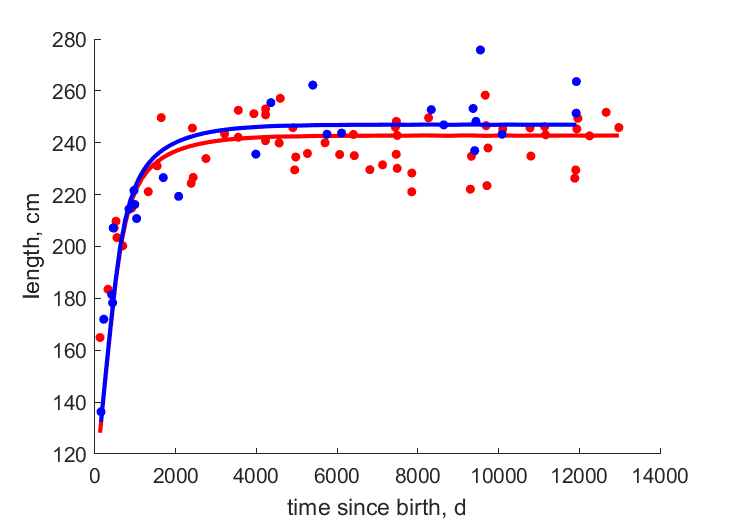Predictions & Data for this entry
| Model: stx | climate: MA, MB, MC | migrate: | phylum: |
| COMPLETE = 2.5 | ecozone: MC | food: bxM, xiCvf, xiCic | class: |
| MRE = 0.030 | habitat: OiMc | gender: Dg | order: |
| SMSE = 0.002 | embryo: Mv | reprod: O | family: |
Zero-variate data
| Data | Observed | Predicted | (RE) | Unit | Description | Reference |
|---|---|---|---|---|---|---|
| tg | 365 | 369.8 | (0.0132) | d | gestation time | AnAge |
| tx | 457.5 | 455.1 | (0.005174) | d | time since birth at weaning | guess |
| tp | 2555 | 2515 | (0.01549) | d | time since birth at puberty for females | AmanYama2013 |
| tpm | 4562 | 4552 | (0.002395) | d | time since birth at puberty for males | AnAge |
| am | 1.716e+04 | 1.715e+04 | (0.0003855) | d | life span | AnAge |
| Lb | 100 | 108.2 | (0.08213) | cm | length at birth | Wiki |
| Lp | 230 | 237 | (0.03051) | cm | length at puberty | AmanYama2013 |
| Lpm | 245 | 250.8 | (0.02376) | cm | length at puberty | AmanYama2013 |
| Li | 275 | 248.1 | (0.09789) | cm | ultimate length for females | Wiki |
| Wwi | 2.25e+05 | 2.317e+05 | (0.02963) | g | ultimate wet weight for females | Wiki |
| Ri | 0.0007828 | 0.0007781 | (0.005968) | #/d | maximum reprod rate | AmanYama2013 |
Uni- and bivariate data
| Data | Figure | Independent variable | Dependent variable | (RE) | Reference |
|---|---|---|---|---|---|
| tL_f |   | time since birth | length | (0.03915) | AmanYama2013 |
| tL_m |   | time since birth | length | (0.0427) | AmanYama2013 |
Pseudo-data at Tref = 20°C
| Data | Generalised animal | Peponocephala electra | Unit | Description |
|---|---|---|---|---|
| v | 0.02 | 0.02604 | cm/d | energy conductance |
| p_M | 18 | 41.53 | J/d.cm^3 | vol-spec som maint |
| k_J | 0.002 | 0.002 | 1/d | maturity maint rate coefficient |
| k | 0.3 | 0.377 | - | maintenance ratio |
| kap | 0.8 | 0.7853 | - | allocation fraction to soma |
| kap_G | 0.8 | 0.8018 | - | growth efficiency |
| kap_R | 0.95 | 0.95 | - | reproduction efficiency |
Discussion
- Males are assumed to differ from females by {p_Am} and E_Hp
- Lactation is taken into account in predictions for tL data
Facts
- Males tend to be larger than females (Ref: ADW)
Bibliography